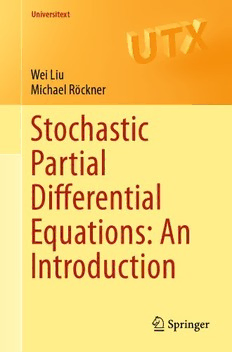Table Of ContentUniversitext
Wei Liu
Michael Röckner
Stochastic
Partial
Differential
Equations: An
Introduction
Universitext
Universitext
SeriesEditors
SheldonAxler
SanFranciscoStateUniversity
VincenzoCapasso
ADAMSS(InterdisciplinaryCentreforAdv)
CarlesCasacuberta
UniversitatdeBarcelona
AngusMacIntyre
QueenMaryUniversityofLondon
KennethRibet
UniversityofCalifornia,Berkeley
ClaudeSabbah
CNRS,EcolepolytechniqueCentredemathématiques
EndreSüli
UniversityofOxford
WojborA.Woyczynski
CaseWesternReserveUniversity,Cleveland,OH
Universitext is a series of textbooks that presents material from a wide variety of mathe-
maticaldisciplinesatmaster’slevelandbeyond.Thebooks,oftenwellclass-testedbytheir
author,mayhaveaninformal,personalevenexperimentalapproachtotheirsubjectmatter.
Someofthemostsuccessfulandestablishedbooksintheserieshaveevolvedthroughseveral
editions,alwaysfollowingtheevolutionofteachingcurricula,toverypolishedtexts.
Thusasresearchtopicstrickledownintograduate-levelteaching,firsttextbookswrittenfor
new,cutting-edgecoursesmaymaketheirwayintoUniversitext.
Moreinformationaboutthisseriesathttp://www.springer.com/series/223
Wei Liu (cid:129) Michael RoRckner
Stochastic Partial Differential
Equations: An Introduction
123
WeiLiu MichaelRoRckner
SchoolofMathematicsandStatistics FacultyofMathematics
JiangsuNormalUniversity BielefeldUniversity
Xuzhou,China Bielefeld,Germany
ISSN0172-5939 ISSN2191-6675 (electronic)
Universitext
ISBN978-3-319-22353-7 ISBN978-3-319-22354-4 (eBook)
DOI10.1007/978-3-319-22354-4
LibraryofCongressControlNumber:2015953013
Mathematics Subject Classification (2010): 60-XX, 60H15, 60H10, 60H05, 60J60, 60J25, 35-XX,
35K58, 35K59, 35Q35, 34-XX, 34F05, 34G20, 47-XX,
47J35
SpringerChamHeidelbergNewYorkDordrechtLondon
©SpringerInternationalPublishingSwitzerland2015
Thisworkissubjecttocopyright.AllrightsarereservedbythePublisher,whetherthewholeorpartof
thematerialisconcerned,specificallytherightsoftranslation,reprinting,reuseofillustrations,recitation,
broadcasting,reproductiononmicrofilmsorinanyotherphysicalway,andtransmissionorinformation
storageandretrieval,electronicadaptation,computersoftware,orbysimilarordissimilarmethodology
nowknownorhereafterdeveloped.
Theuseofgeneraldescriptivenames,registerednames,trademarks,servicemarks,etc.inthispublication
doesnotimply,evenintheabsenceofaspecificstatement,thatsuchnamesareexemptfromtherelevant
protectivelawsandregulationsandthereforefreeforgeneraluse.
Thepublisher,theauthorsandtheeditorsaresafetoassumethattheadviceandinformationinthisbook
arebelievedtobetrueandaccurateatthedateofpublication.Neitherthepublishernortheauthorsor
theeditorsgiveawarranty,expressorimplied,withrespecttothematerialcontainedhereinorforany
errorsoromissionsthatmayhavebeenmade.
Printedonacid-freepaper
Springer International Publishing AG Switzerland is part of Springer Science+Business Media
(www.springer.com)
Contents
1 Motivation,AimsandExamples ........................................... 1
1.1 MotivationandAims................................................... 1
1.2 GeneralPhilosophyandExamples .................................... 3
2 The Stochastic Integral in General Hilbert Spaces
(w.r.t.BrownianMotion).................................................... 9
2.1 Infinite-DimensionalWienerProcesses ............................... 9
2.2 MartingalesinGeneralBanachSpaces................................ 23
2.3 TheDefinitionoftheStochasticIntegral.............................. 27
2.3.1 SchemeoftheConstructionoftheStochasticIntegral....... 27
2.3.2 TheConstructionoftheStochasticIntegralinDetail........ 27
2.4 PropertiesoftheStochasticIntegral................................... 42
2.5 TheStochasticIntegralforCylindricalWienerProcesses ........... 49
2.5.1 CylindricalWienerProcesses.................................. 49
2.5.2 The Definition of the Stochastic Integral
forCylindricalWienerProcesses.............................. 52
3 SDEsinFiniteDimensions.................................................. 55
3.1 MainResultandALocalizationLemma.............................. 55
3.2 ProofofExistenceandUniqueness.................................... 62
4 SDEsinInfiniteDimensionsandApplicationstoSPDEs................ 69
4.1 GelfandTriples,ConditionsontheCoefficientsandExamples...... 69
4.2 TheMainResultandAnItôFormula ................................. 89
4.3 MarkovPropertyandInvariantMeasures............................. 109
5 SPDEswithLocallyMonotoneCoefficients............................... 123
5.1 LocalMonotonicity .................................................... 123
5.1.1 MainResult..................................................... 123
5.1.2 ProofoftheMainTheorem.................................... 126
5.1.3 ApplicationtoExamples....................................... 133
v
vi Contents
5.2 GeneralizedCoercivity................................................. 145
5.2.1 MainResults ................................................... 145
5.2.2 ProofsoftheMainTheorems.................................. 149
5.2.3 ApplicationtoExamples....................................... 165
6 MildSolutions................................................................ 179
6.1 PrerequisitesforThisChapter ......................................... 179
6.1.1 TheItôFormula................................................ 179
6.1.2 ABurkholder–Davis–GundyTypeInequality................ 180
6.1.3 StochasticFubiniTheorem.................................... 181
6.2 Existence,UniquenessandContinuitywith Respect
totheInitialData....................................................... 181
6.3 SmoothingProperty of the Semigroup:Pathwise
ContinuityoftheMildSolution ....................................... 201
A TheBochnerIntegral........................................................ 209
A.1 DefinitionoftheBochnerIntegral..................................... 209
A.2 PropertiesoftheBochnerIntegral..................................... 211
B NuclearandHilbert–SchmidtOperators ................................. 215
C ThePseudoInverseofLinearOperators.................................. 221
D SomeToolsfromRealMartingaleTheory ................................ 225
E WeakandStrongSolutions:TheYamada–WatanabeTheorem........ 227
F ContinuousDependenceofImplicitFunctionsonaParameter ........ 241
G Strong,MildandWeakSolutions.......................................... 243
H SomeInterpolationInequalities............................................ 247
I Girsanov’sTheoreminInfiniteDimensionswithRespect
toaCylindricalWienerProcess............................................ 251
References......................................................................... 261
Index............................................................................... 265
Chapter 1
Motivation, Aims and Examples
1.1 Motivation andAims
In this course we will concentrate on (nonlinear) stochastic partial differential
equations (SPDEs) of evolutionary type. All kinds of dynamics with stochastic
influence in nature or man-made complex systems can be modeled by such
equations. As we shall see from the examples at the end of this section, the state
spaces of their solutions are necessarily infinite dimensional, such as spaces of
(generalized)functions.Inthiscoursethestatespaces,denotedbyH,willbemostly
separableHilbertspaces,sometimesseparableBanachspaces.
There is also enormousresearch activity on SPDEs where the state spaces are
notlinear,butratherspacesofmeasures(particlesystems,dynamicsinpopulation
genetics) or infinite-dimensionalmanifolds(path or loop spaces over Riemannian
manifolds).
There are basically three approaches to analyzing SPDEs: the “martingale
(or martingale measure) approach” (cf. [80]), the “semigroup (or mild solution)
approach” (cf. [26, 27]) and the “variational approach” (cf. [75]). There is an
enormously rich literature on all three approaches which cannot be listed here.
We refer instead to the above and the following other monographs on SPDEs:
[6,13,16,19,20,26–28,37,46,48,50,53,66]andthereferencestherein.
The purpose of this course is to give an introduction to the “variational
approach”,asself-containedaspossible,includingthe“localcase”,i.e.where,e.g.
thestandard(weak)monotonicityconditionsonlyholdlocally.Inthe“globalcase”
thisapproachwasinitiatedinthepioneeringworkofE.Pardoux[64,65]andfurther
developed by N. Krylov and B. Rozovski˘ı in [54] for continuous martingales as
integratorsin the noise term and later by I. Gyöngyand N. Krylovin [40–42] for
notnecessarilycontinuousmartingales.
The predecessor [67] of this monograph grew out of a two-semester graduate
coursegivenbythesecond-namedauthoratPurdueUniversityin2005/2006.This
extendededitionof[67]istheoutcomeofatwosemestergraduatecourseheldatthe
©SpringerInternationalPublishingSwitzerland2015 1
W.Liu,M.Röckner,StochasticPartialDifferentialEquations:AnIntroduction,
Universitext,DOI10.1007/978-3-319-22354-4_1
2 1 Motivation,AimsandExamples
UniversityofBielefeldin2012/2013.Prerequisiteswouldbeanadvancedcoursein
probabilitytheory,coveringstandardmartingaletheory,stochasticprocessesinRd
and maybe basic stochastic integration, thoughthe latter is not formally required.
Sincegraduatestudentsinprobabilitytheoryareusuallynotfamiliarwiththetheory
of Hilbert spaces or basic linear operator theory, all required material from these
areasis includedin the text,mostof it in the appendices.Forthe same reason we
minimizethegeneraltheoryofmartingalesonHilbertspaces,paying,however,the
pricethatsomeproofsconcerningstochasticintegrationonHilbertspaceare a bit
lengthy,sincetheyhavetobedone“withbarehands”.
For simplicity we specialize to the case where the integrator in the noise term
is just a cylindricalWiener process, but everythingis spelt outin such a way that
itgeneralizesdirectlytocontinuouslocalmartingales.Inparticular,integrandsare
alwaysassumedtobepredictableratherthanjustadaptedandproductmeasurable.
The existence and uniqueness proof (cf. Sect.4.2) is our personal version of the
proofin [54,75] and is largelytaken from [69] presented there in a more general
framework.Theresultsoninvariantmeasures(cf.Sect.4.3)wecouldnotfindinthe
literature for the “variational approach”.They are, however,quite straightforward
modificationsofthoseinthe“semigroupapproach”in[27].
Tokeepthiscoursereasonablyself-containedwealsoincludeacompleteproof
ofthefinite-dimensionalcasein Chap.3,whichisbasedonthe veryfocussedand
beautiful exposition in [52], which uses the Euler approximation. Among other
complementing topics such as Chap.6, which contains a concise introduction to
the “semigroup (or mild solution) approach”, the appendices contain a detailed
accountoftheYamada–WatanabeTheoremontherelationbetweenweakandstrong
solutions(cf.AppendixE),anda detailedproofofGirsanov’sTheoremininfinite
dimensions(cf.AppendixI).
The structureofthis monographis, we hope,obviousfromthe list ofcontents.
Here,weonlymentionthatasubstantialpartconsistsofaverydetailedintroduction
to stochastic integration on Hilbert spaces (see Chap.2), major parts of which (as
well as Appendices A–C) are taken from the Diploma thesis of Claudia Prévôt
(née Knoche) and Katja Frieler (see [34]), which in turn was based on [26] and
supervisedbythesecondnamedauthorofthismonograph.Wewouldliketothank
bothofthematthispointfortheirpermissiontodothis.Wethankallcoauthorsof
thosejointpaperswhichformanothercomponentforthebasisofthismonograph.It
wasreallyapleasureworkingwiththeminthisexcitingareaofprobabilitytheory.
We would also like to thank Nelli Schmelzer, Matthias Stephan, Sven Wiesinger
and Lukas Wresch for the excellent type job, as well as the participants of the
graduatecoursesatPurdueandBielefeldUniversityforcheckinglargepartsofthe
textcarefully.Special thanksgo to MichaelScheutzow and Byron Schmulandfor
spotting a number of misprints and small errors in [67]. We also thank Claudia
Prévôtforgivingpermissionforthisextensionof[67].Furthermore,thefirstnamed
authoracknowledgesthefinancialsupportfromNSFC(No.11201234,11571147)
and a project funded by PAPD of Jiangsu Higher Education Institutions. The last
named author would like to thank the German Science Foundation (DFG) for its
financial support through SFB 701 and also Jose Luis da Silva for his hospitality
1.2 GeneralPhilosophyandExamples 3
duringaverypleasantstayattheUniversityofMadeirawherethefinalproofreading
ofthismonographwasdone.
1.2 General PhilosophyandExamples
Before starting with the main body of this course, let us briefly recall the general
philosophy of describing stochastic dynamics by stochastic differential equations
(SDE) in a more heuristic and intuitive way. These usually take values in a space
H of(generalized)functions,e.g.onadomainƒ (cid:2) Rd,oradifferentialmanifold,
afractalorevenmerelyinanarbitrarymeasurablespace.ƒ;B/.Abstractly,H isa
separableHilbertorBanachspace.ThengivenamapF WŒ0;T(cid:2)(cid:3)H(cid:3)U !H,where
T 2(cid:2)0;1ΠandU isanotherseparableHilbertspace,oneconsidersthe differential
equations
dX.t/
DF.t;X.t/;WP.t// (1.1)
dt
on H. Here WP.t/;t 2 Œ0;T(cid:2), is a U-valued white noise in time, more precisely,
thegeneralisedtimederivativeofaU-valuedcylindricalBrownianmotionW.t/ D
.Wk.t//k2N;t 2Œ0;T(cid:2),onsomeprobabilityspace.(cid:3);F;P/.HenceWP.t/;t 2Œ0;T(cid:2),
areindependentcentredGaussianvariableswithinfinitevariance,henceinregardto
(1.1)the“worst”(Gaussian)randomperturbationthatcanoccurin(1.1).Employing
aTaylorexpansionforFaround02Uand,neglectingtermsoforder2andhigher,
turns(1.1)into
dX.t/
DF.t;X.t/;0/CD3F.t;X.t/;0/WP.t/; (1.2)
dt
whereD3FdenotesthederivativeofFwithrespecttoitsthirdcoordinate.Setting
A.t;x/WDF.t;x;0/; B.t;x/WDD3F.t;x;0/
andtakingintoaccountthenon-differentiabilityofW.t/int,(1.2)turnsinto
dX.t/DA.t;X.t//dtCB.t;X.t//dW.t/; (1.3)
to be rigorously understoodin integral form. We mention here that the stochastic
termin(1.3)isoftencalledorinterpretedasa“stochasticforce”,thoughtheequa-
tion is first order. This can, however, be justified by the Kramers–Smoluchowski
approximation(see [14, 15, 33, 51, 76]). Furthermore, A is called the drift of the
equation.
We briefly recall here that the linear pendant of (1.3) is given by the associ-
ated Fokker–Planck–Kolmogorovequationsobtained as a linearization of (1.3) as

